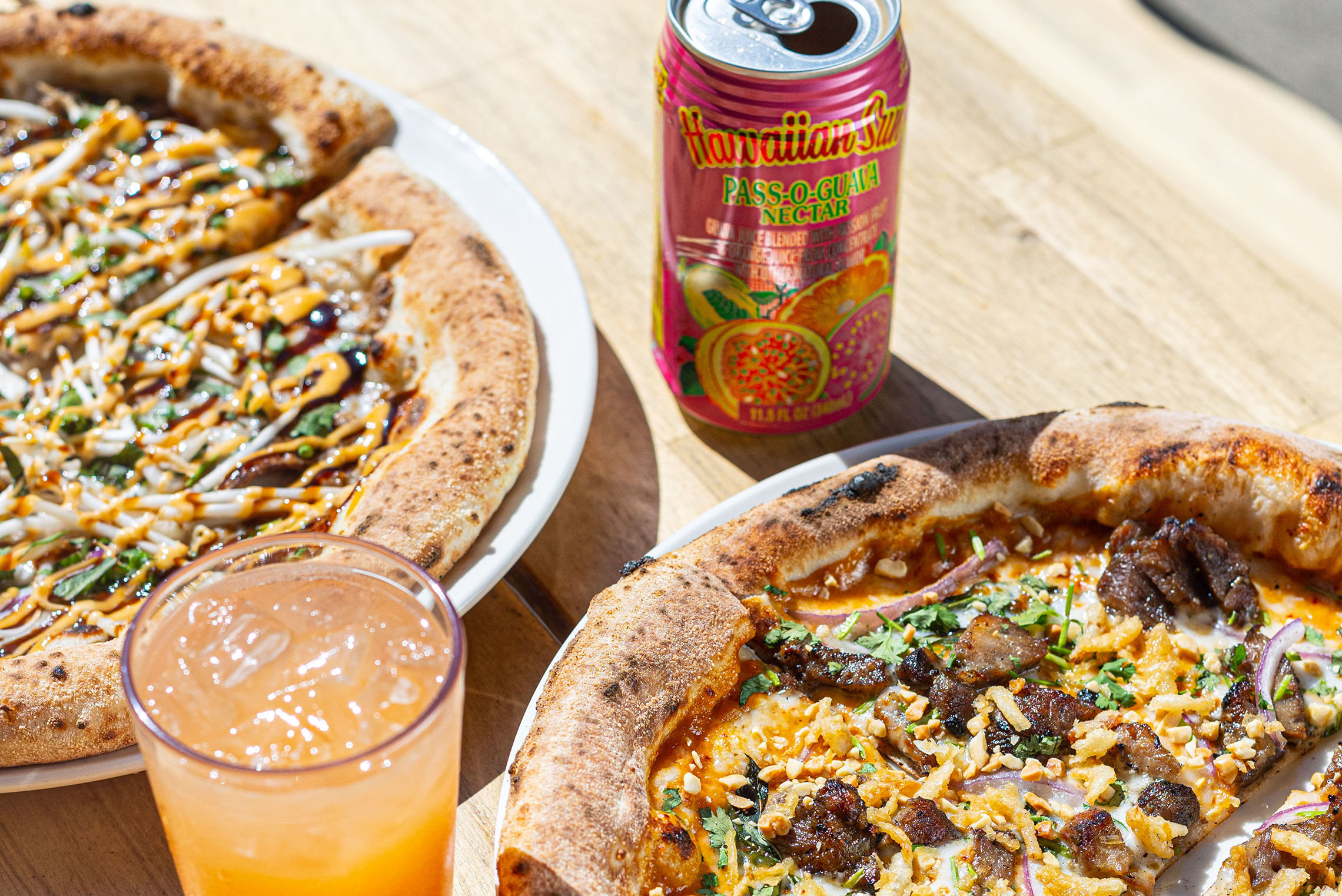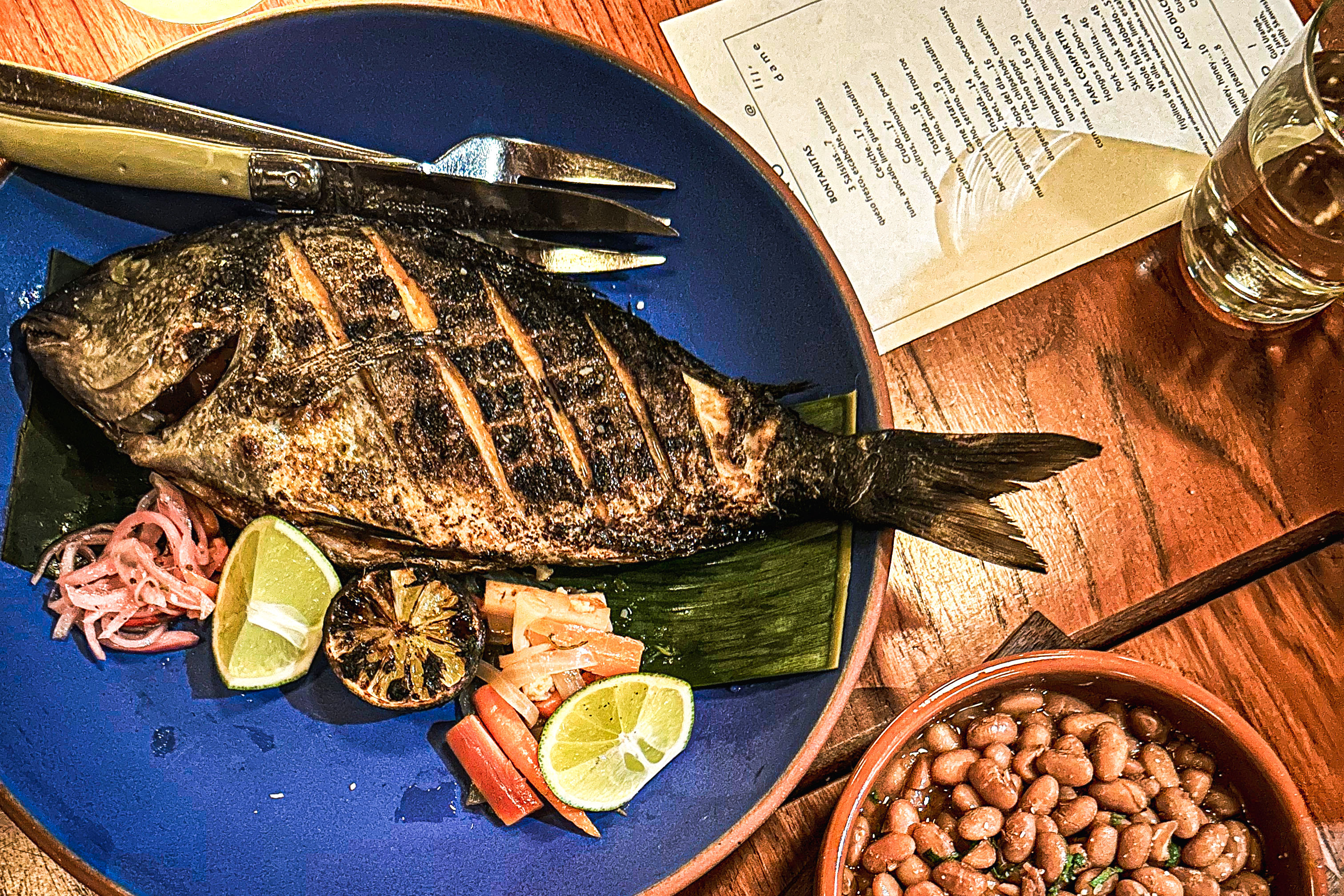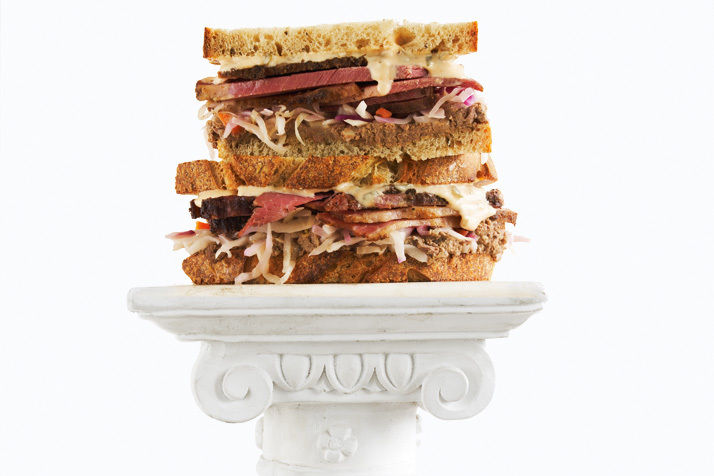
The Art of Eating Cheaply
25 Meals for Under $25
Stop. Drop that slice of greasy pizza or that grizzled taco you’re about to bite into. Take a deep breath. Think for a moment. Is this really what you want to eat? Really?
But, you say, times are hard. And that $600 tax rebate check doesn’t mean you can just sit around frivolously dining on foie gras bonbons for the rest of your life.
We know. But there are tacos, and there are tacos. There’s pizza, and then there’s pizza. We’re talking masterpieces. We’re talking works of culinary art that inspire and transport us—cheap, good food that makes our recessionary lives seem far from hopeless.
After all, if chef Oswaldo Bibiano of the Northeast Portland Mexican restaurant Autentica cares enough to make his $3 taco the work of art that it undeniably is, we should care enough to bike all the way across town (you know, to save on gas money) just for the privilege of savoring it. This appreciation, of course, might have something to do with the care that Bibiano brings to the creation of every taco: for instance, the way he places a homemade corn tortilla on top of the meat while it’s sizzling in the pan, so that as the meat’s fragrant juices evaporate, they subtly season the tortilla. In our book, that’s a taco. And that’s just one of many reasons Bibiano’s masterwork is superior to most other tacos in town.
Fortunately, there are plenty of other well-studied chefs in town who’ve managed to make dining on a budget as tantalizing as it is to fork over $100 to feast on a meal for two at Le Pigeon. And it’s these chefs—these men and women who know that a good meal cannot be judged by price alone—who have inspired our list of 25 meals for under $25. We know $25 is no small price to pay for two entrées and an appetizer (and yes, that’s without alcohol), but in this day and age, it’s a darn good deal.
So, no matter how slim your wallet, follow our guide to the best—nay, most sublime—cheap eats in Portland. We guarantee that after your meal, you’ll feel nary a hint of buyer’s remorse. —Camas Davis
ITALIAN
Bar Dué
Sure, it has “bar” in its name, but think of it more as an incredibly civilized restaurant, albeit one that sports rather tall tables and stools. A less expensive annex to the Pearl District’s Fratelli restaurant, Bar Dué’s hallway-sized interior is graced by dark, sage-green walls; high-backed leather banquettes; and a curving, rough-hewn wood bar. The Italian menu is equally classy, not to mention impressively affordable. Each of the six pizzas—we like the smoked corn, pulled duck, and roasted garlic cream combination—costs only $12, and they’re enough for two people. But eating well here means ordering a couple of small plates ($7 apiece) to fill you up: for instance, a bowl of thick and creamy polenta topped with melted mozzarella and prosciutto, or a panini of braised beef, spiced pickle, and onion marmalade. Also note that these so-called “small plates” aren’t all that small, and if you order two, you’ll still have plenty of change to dedicate to a few crostini or bruschetta, or a plate of salami and cheese, plus a glass of wine or two. Not too shabby for a “bar.” —CD
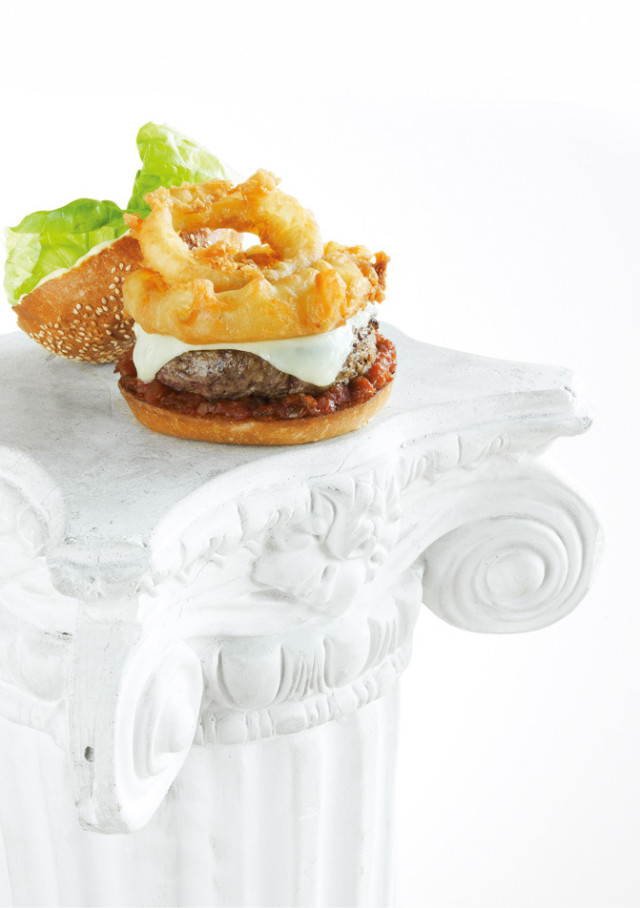
SLOW BAR’s $9 Hamburger
Image: Stuart Mullenberg
THE MASTERPIECE
Slow Bar’s $9 Hamburger
Higher Ground
Change was inevitable: Once the definitive meal of a newly motorized nation, the burger has morphed from a staple of grab-and-go culture into a gourmet centerpiece worthy of inclusion in any fine-dining establishment. But while cities like New York have given in to wallet-busting monstrosities like $32 truffle-and-foie-gras burgers (served at chef Daniel Boulud’s DB Bistro Moderne), in Portland, we’re more interested in the simple pleasures of beef and bun. Of course, “artisanal” (i.e., fresh, not frozen) hamburgers made from locally produced, grass-fed beef have been known to reach a dizzying $14 here (and no, that doesn’t include fries, or a massage and a free car wash on the side). But there are still plenty of eco-friendly versions ’round these parts that can be savored for under $10—which is where we draw the line on our burger budget, frankly.
The most perfect under-$10 burger in Portland? It’s the sculpted pantheon of beefy brawn and Olympian flavor—otherwise known as the Slow Burger—that’s made so lovingly at Slow Bar (533 SE Grand Ave, slowbar.net). Here’s why. —John Chandler
THE BUN:
When you’re serving a hulking half-pounder, one of those unimpressive, store-bought, deflated buns just won’t do. You need a powerful bun, one with good structure that won’t fall apart under the weight of the meat. It should have a little substance to it when you bite into it, and it shouldn’t taste like it’s filled with air. Slow Bar uses sturdy and voluminous brioche rolls from Grand Central Baking Co. Aside from their heft, their chew factor adds one more pleasant dimension to the textural symphony of crisp lettuce and juicy patty.
THE MEAT:
Slow Bar’s co-owner Mike Banash and his kitchen crew selected their meat source through a series of blind taste tests. Turned out the half-pound patty made from free-range Strawberry Mountain ground beef beat out those they’d prepared from both Cascade Natural and Painted Hills ground beef.
Slow Bar’s patty contains a mixture of beef, egg, and an assortment of herbs and spices that the kitchen refuses to name. The beef is meticulously weighed to eight ounces and cut with a mold to ensure that each burger cooks consistently every time. By cooking the patty on a flat grill, cooks can seal in the meat’s juice, as opposed to charbroiling, which can leave the diner with a wizened hockey puck.
Banash believes that “true medium” is the proper way to enjoy the Slow Burger. The result is an incredibly plump patty bursting with juice that, ironically, is impossible to eat slowly or with any sense of propriety.
THE SECRET INGREDIENT:
Rather than using raw onion slices, which tend to overpower the rest of the burger, Slow Bar stacks two beer-battered onion rings on top of the beef. While some customers leave the onion rings in situ and wedge the monstrous burger into their pieholes, others take them out and eat them with a string of melted gruyère cheese attached. We prefer to do both: Remove the gooiest ring and eat that. Leave the second ring in the burger to provide crunchy texture and sweet flavor to the peerless ensemble.
THE GARNISH:
Slow Bar slathers its buns with a garlicky house-made aioli and a smoky ketchup-spiked pickle relish bolstered by horseradish and cayenne pepper. Rather than strong cheddar or gouda, Slow Bar prefers the nutty, quiet, but complex flavors of gruyère for the layer of cheese. A leaf or two of crisp, fresh butter lettuce tops it all off. The result? Each ingredient works harmoniously with the next—in fact, they all downright sing.
INDIAN
Chennai Masala
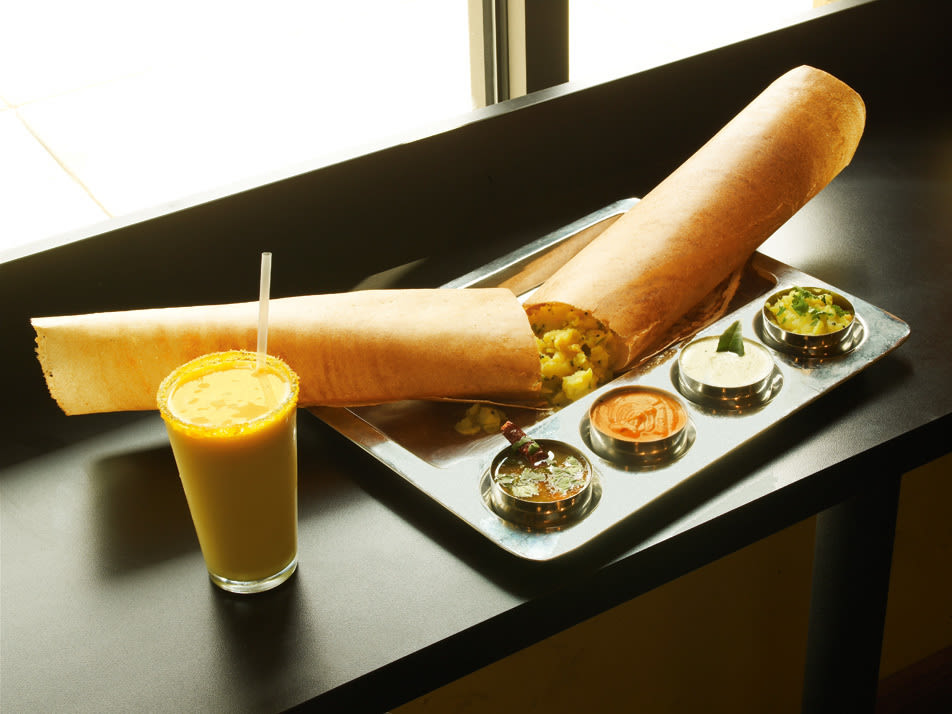
Wash down CHENNAI MASALA’s paper roast dosa, filled with curried potatoes and onions, with a sweet mango lassi.
Image: Stuart Mullenberg
To partake of a truly great meal at this South Indian eatery, diners may have to step outside of their comfort zones. And we don’t mean just their geographic comfort zones (the restaurant is located about a 30-minute drive west of downtown). To sample the very best dishes at Chennai Masala, we suggest forgoing the standard dishes that you’ll find in just about every Indian restaurant in Portland proper—like chicken tikka masala or samosas (though they are quite good here)—and opting instead for a couple of dosas ($9-15). Slightly sour, crispy, one-and-a-half-foot-wide crêpes, the dosas are filled with any number of savory delights, from curried chickpeas (chole dosa) to seasoned potatoes and onions (masala dosa). Meant to be eaten with your hands, one dosa can feed two people. But if you’re really hungry, opt for the family dosa ($15). Technically it’s meant to feed three, but if it’s just the two of you, you might as well see if you can stretch your stomachs’ comfort zones, too. —CD
JEWISH
Kenny & Zuke’s Delicatessen
Before a trip to Kenny & Zuke’s Delicatessen, it’s wise to practice a couple of jaw-relaxing yoga exercises, since the downtown Jewish eatery—famous for its house-cured pastrami—assembles towering sandwiches designed for someone with an open mouth the size of a reticulated python’s. While it’s fair to gripe about the inclusion of $12 sandwiches in a guide to cheap eats, suffice it to say that one of these massive meat bombs makes for two heart-palpitating meals. But in order for a carnivorous couple to get their fix for under $25—and wash it all down with a Sioux City Sarsaparilla ($2.75)—a little cooperation is in order. We recommend a generously slabbed pastrami sandwich ($11.25) and the Big Salad ($10.50)—a bounty of crisp veggies, egg slices, and bagel chips, bolstered with your choice of pastrami, chicken, or lox. Employ the wisdom of Solomon when divvying up this heavenly spread. And remember to stretch first. —JC
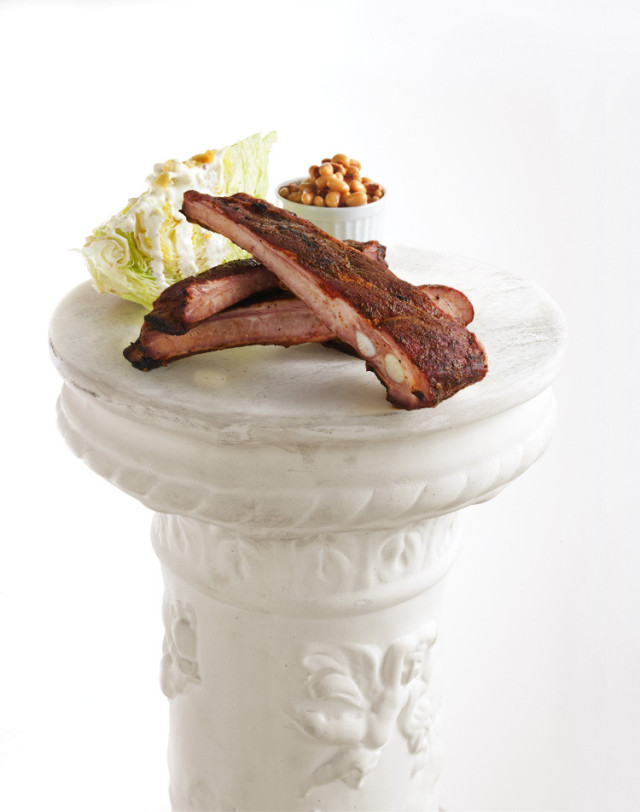
PODNAH’S $12 Pork Ribs
Image: Stuart Mullenberg
THE MASTERPIECE
Podnah’s $12 Pork Ribs
Ribbed from the Gods
There is nothing subtle about eating barbecue. Juices squirt. Fingers get greasy. Flesh is torn asunder and lodged between teeth. But when wrapping your mitts and mouth around something that might be described as the hickory-smoked hand of God, the mess is undeniably worth it.
Whether clinging to charred bone or piled up on bread, proper barbecue is a hedonistic—not to mention cheap, filling, and generously portioned—celebration of meat in its purest form. In fact, it’s a direct line to the caveman in all of us. And, like the Tower of Babel, it sizzles with a million different dialects: Wet or dry. Spicy or sweet. Vinegary or mustardy.
Of course, we can’t deny that the best barbecue dialect is spoken in the South, which can be a problem for those of us living outside of that delicious slab of the country from Texas to South Carolina known as the Barbecue Belt.
But we need not twiddle our Wet Naps in frustration—the lust for quality ’cue in Portland is strong, and though there are numerous joints serving oversauced slabs of shoe leather, there are just as many keeping our discerning palates sated.
But put a baster to our head? We prefer to do our bone suckin’ with the smoked pork ribs at Podnah’s Pit (1469 NE Prescott St, podnahspit.com), a place that’s unabashedly all about the pig. —Bart Blasengame
THE RUB:
In the world of ribs, what’s on the outside goes way beyond being an artistic statement—it says a lot about the chef’s general worth as a human being. And in that sense, Podnah’s mastermind Rodney Muirhead is right up there with Mother Teresa. For his ribs, the Waxahachie, Texas, native goes the purist route—what connoisseurs call the “dry rub.” In this case, that means dabbing each pork rib in a fine layer of sugar and secret spices, which, when properly smoked, leaves each massive rectangle of meat with a brown, slightly crispy exterior that acts as a portal to the tender flesh underneath. If you must sauce, a Carolina-style vinegar sauce and a traditional sweet, ketchup-based sauce is available at the table.
THE MEAT:
A great rib should be a little crusty on the outside, pink and soft on the inside, and it should practically fall off the bone. The first step is starting with quality meat that’s marbled with fat so that it doesn’t dry out as it’s smoking—Muirhead once used Carlton Farms pork ribs, but because they were too lean, he switched to Iowa Gold pork ribs from Oklahoma. But the second step—the smoking process—is just as important. Most mornings, the Texas native lights the fire in his oak- and mesquite-filled wood-pit at 5 a.m. to begin the slow-cooking process. He smokes his spice-rubbed ribs for four to six hours and rarely moistens the exterior, choosing instead to allow the slivers of fat within the meat to keep things juicy. Besides the rub, the oak fumes provide the most flavor, wafting through muscle and sinew to give each bite a subtle, woodsy taste.
THE ACCOMPANIMENTS:
Smokey had the Bandit. Vader had Skywalker. Every strong character needs a worthy adversary, and what’s a better foil to pure, unadulterated meat worship than a mountain of cold, refreshing, crispy iceberg lettuce, preferably slathered with a tangy, homemade blue cheese dressing and topped with croutons? At the very least, it’ll make you feel healthy. Or something. And then you can balance that out with a requisite bowl of salty, ham-studded beans.
SEAFOOD
The Fishwife
The Fishwife should come with one of those blaring, caffeine-addled radio voice-overs: Prices so low, you’ll think we’re craazzzzyyyy. Because when comparing the high quality of the food inside this working-class joint with the minuscule size of your bill, that’s exactly the thought that will cross your mind: Are the owners of this North Portland seafood haven nuts? Flaky slabs of Alaskan cod with salad and a side for $11.25? Humongous bowls of New England-style clam chowder for under $5? Don’t avert your eyes from the pricier portions of the menu, either. Not when you and your cohort can share something like mussels stewed in apples, bacon, brandy, and cream ($13.50), or a cioppino ($14.50) piled high with cod, snapper, prawns, scallops, and bay shrimp, and still keep tight to the magical $25 ceiling. Usually, seafood is either cheap and greasy or pricey and precious. The Fishwife is neither. Get there before the owners wise up. —B. Blasengame
ITALIAN
Piazza Italia
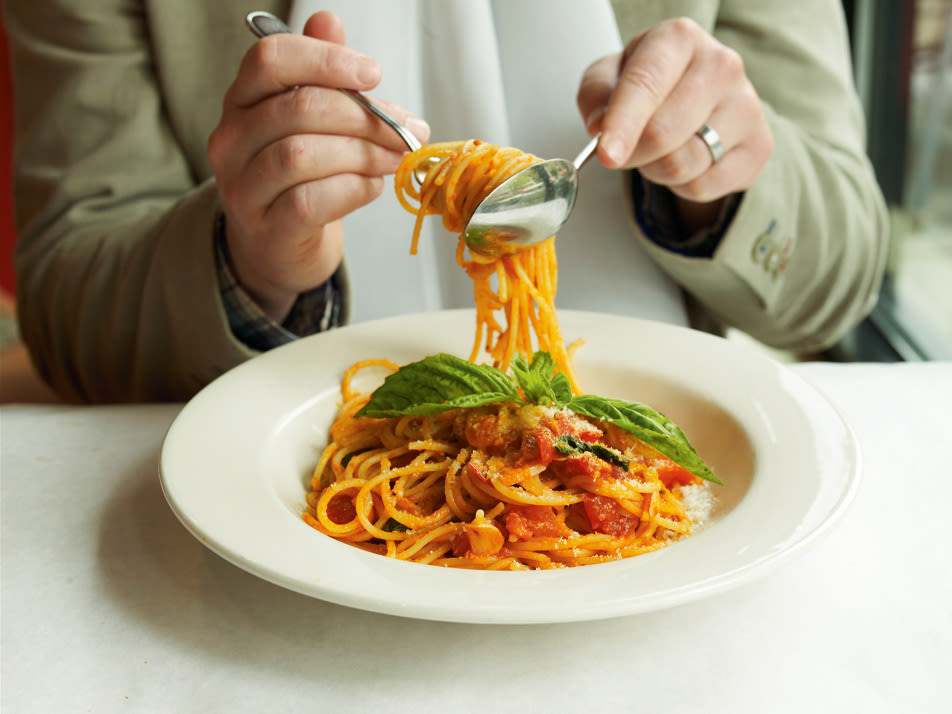
Spaghetti al pomodoro at PIAZZA ITALIA
Image: Stuart Mullenberg
At this authentic Italian eatery, just west of Jamison Square in the Pearl District, a soft glow radiates from the windows. Tables are filled with patrons clinking glasses. An elderly gentleman dances, kissing his matronly partner’s rosy cheeks as a ballad from the Old Country twinkles from the speakers. “Grazie, grazie,” the host says to a couple waving their goodbyes. While you’re poring over the menu, you realize just how remarkable this restaurant is—most dishes hover right around $12. Your date, practically swooning, says, “This reminds me of traveling in Italy.” You may order any number of salads—from the Gino’s Salad ($10.25), filled with gorgonzola, apples, and mixed nuts, to the Antipasto Italiano ($10.25), but the pasta is really where it’s at. Dishes like the linguine squarciarella ($12.50)—a steaming mountain of rough-cut prosciutto and egg noodles—or a classic pasta alla Bolognese ($12.50) are proportioned for sharing. After your noodles, it’s tempting to linger over an espresso, but you may opt instead for a walk in the square, which, in your sated state, you may believe is a romantic piazza. —Brian Barker
KOREAN
Toji Korean Grill House
Don’t be fooled by the price of the bulgogi and galbi. Although the Korean barbecue runs between $13.95 and $24.95 at this clean-and-shiny Hawthorne joint—a favorite among visiting Korean businessmen—it easily feeds two people, if not more. Plus, you get to cook all that sweet-and-salty meat on an individual grill set into the table, and your meal comes with at least six different bowls of kimchi. If your appetites are larger, you can always supplement the meat-fest with house-made pork dumplings ($4.95) or pan-fried tofu ($4.95). Or opt for the bi bim bob ($9.95), a bowl of steamed rice topped with spiced slices of beef, zucchini, daikon, bean sprouts, shaved carrots, an egg, and a pungent pepper sauce; or any number of soups, such as the spicy soon tofu ($8.95), studded with baby shrimp and calamari. Between the flavor and the portions of these dishes, the pleasure-to-price ratio is just right. —CD
SCANDINAVIAN
Bröder
Frukost and middag—“breakfast” and “lunch” to you—are the main attractions at this tiny hallway of a café on SE Clinton Street. And for both of these ever-so-important Scandinavian meals, it’s all about appealingly subtle spareness. Think a platter of cured salmon or pickled herring ($5 for an appetizer; $9 for an entrée) with brown bread, pickled cucumbers, and horseradish cream for lunch. Or airy puffs of the eggy dough known as aebleskivers ($8) slathered with lingonberry jam, lemon curd, or maple syrup for breakfast. Or Swedish meatballs ($9) swimming in a luxurious sherry cream sauce. No matter what you order here, almost everything comes with a salad, pickled vegetables, and walnut toast. And in each dish, the flavors are simple but rich, the composition elemental and comforting. In other words, it’s just the kind of minimalist food you’ll want to spend a leisurely morning or afternoon maximizing your time with. —CD
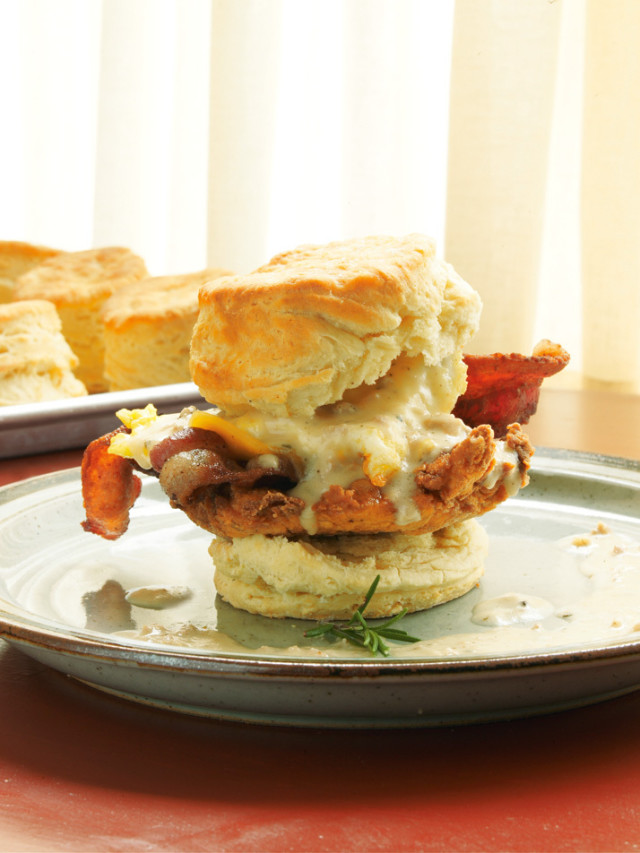
The Reggie sandwich at PINE STATE BISCUITS combines fried chicken, bacon, cheddar cheese, and gravy on a buttermilk biscuit.
Image: Stuart Mullenberg
SOUTHERN
Pine State Biscuits
If you can snag one of the three tables at Pine State Biscuits, don’t hesitate. Otherwise, after you’ve done your time on the sidewalk waiting to order, get your fare to go and find an empty park bench in nearby Laurelhurst Park. And yes, that bench must be empty. You don’t want to be rubbing elbows with anybody when you finally sink your teeth into the McIsley ($6), a flaky buttermilk biscuit sandwich of fried chicken, sweet pickles, mustard, and honey that deserves your undivided attention. Nor do you want to be distracted when you’re feasting on a biscuit doused with creamy, herbaceous shiitake mushroom gravy ($5). Even if you’re simply slathering a spoonful of huckleberry jam on one of Pine State’s peerless biscuits ($3), you’ll need to be able to focus, in order to thoroughly cover every inch of that buttery goodness. —Megan Callow
AMERICAN
Victory
The owners of Victory describe their establishment as, simply, “a bar with good food.” But let us expand on the humble definition of this Southeast Portland drinking hole. It’s more of a quiet, sultry, sexy bar with sublime food. Not that the food is in any way complex or high falutin’. No, it’s the simplicity of the plates served here that we love so much. Try as we might to branch out from our favorites, we never can seem to order anything but the following perfect triumvirate of flavors: a silky, decadent roasted pork belly and white bean stew ($9) spiked with sweet carrots and brussels sprouts; a bowl of sizzling, creamy baked spätzle ($7) topped with gruyère and crispy shallots; and a plate of house-smoked trout with horseradish cream and house-made rye crackers ($8). Admittedly, there aren’t many vegetables in the combination—although you could round out your meal with one of the tasty salads on the menu each day—but between the succulent meat, the decadent cheese, and the velvety fish, you’ve pretty much got all the most enticing flavor groups covered. And if that doesn’t represent “a bar with good food,” really, what does? —CD
SOUTHERN
Screen Door
Even the most hardened "been there, eaten that" foodie will leave Screen Door a believer.
A little before 10 p.m. on a warm Saturday evening, this East Side bastion of country fare feels like a Maker’s-Mark-fueled church social just hitting its raucous stride. Blame all the whooping and wailing on the Screen Door Plate ($12.95): a design-your-own ensemble of three house sides from their regular menu or their organic vegetables menu, which garners boisterous approval from both carnivores and vegetarians. Options for the Screen Door Plate change weekly, but might include a hungry-man portion of crispy-fried catfish accompanied by walnut-topped asparagus cooked in brown butter, and a salad of baby romaine and avocado. Or a succulent serving of thin-sliced pork chop accompanied by bacon-infused collard greens and a corn cake topped with pickled veggies. By our calculations, that makes six high- and lowbrow flights of Southern comfort for just a few cents over $25. Between the eats and the hospitality, even the most hardened “been there, eaten that” foodie will leave a believer. —Stacey Wilson
VIETNAMESE
Banh Cuon Tan Dinh
Why is it that finger food almost always costs less? Are forks really that expensive? Not that we’re complaining. After all, at Banh Cuon Tan Dinh, a strip-mall hideaway with chartreuse walls and tinny pop tunes, the very best meal on the menu is the Bun Cha Ha Noi ($7), a large platter-for-two that’s piled high with ingredients meant for custom-building your own delectable, handheld rolls. Dip a sheet of dried rice paper into a bowl of warm water to moisten it, then fill it with vermicelli noodles; strips of pickled carrot and daikon; leaves of basil, mint, cilantro and lettuce; and tender bits of barbecued pork and pork patties. Roll it up. Dunk it in a tangy and sweet mixture of lime juice, chiles, and fish sauce. Devour. Of course, there are plenty of other variations on this do-it-yourself theme worth exploring too, but there’s no reason to stray toward anything on the menu that requires utensils. It’ll just cost you more, and it won’t taste nearly as good. —Camela Raymond
BAKERY
Ken’s Artisan Bakery
Whether for breakfast, lunch, or dinner, we find ourselves going back to the lively, sunlit dining room at Ken’s Artisan Bakery again and again. More akin to a French bistro than to a bakery (though they do bake all of their own bread and pastries on the premises), Ken’s has all the right dishes to fuel a morning spent dawdling over the Sunday Times and a Stumptown latte. A croque monsieur ($6.45) is best for such an occasion: Made with country brown bread that’s been toasted to perfection, the open-face sandwich is topped with warm béchamel, gooey gruyère cheese, and baked portobello slices or smoked ham. If you prefer lingering in the late afternoon, a simple sandwich of jambon serrano and butter ($4.50) served on a length of French bread, pairs well with a glass of Côtes du Rhône and a lightly dressed green salad. And since either meal will hardly affect your bottom line, you might as well top it off with a chocolate praline pecan tart ($4.95), a decadent end to the perfect meal. —MC
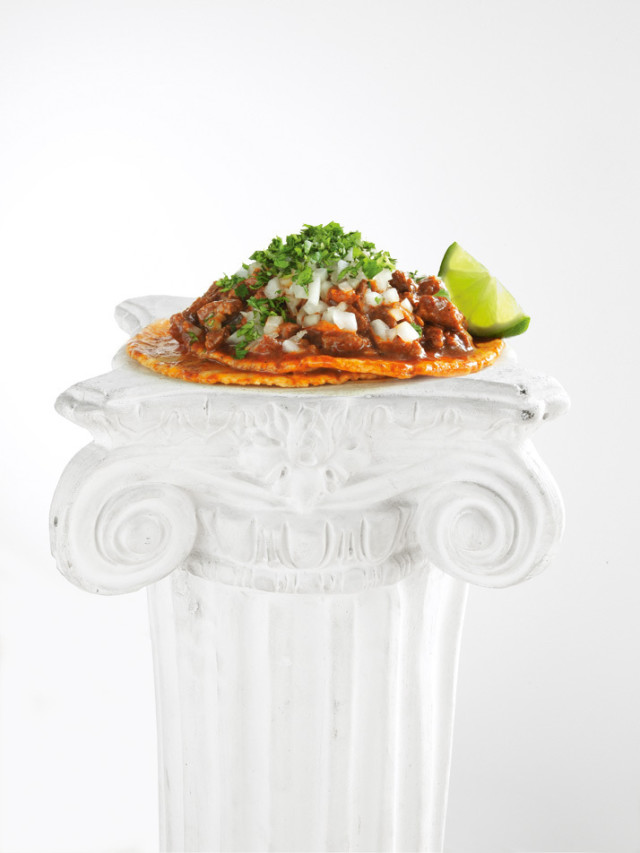
AUTENTICA’s $3 Taco
Image: Stuart Mullenberg
THE MASTERPIECE:
Autentica’s $3 Taco
North of the Border
When you think of places where you’re likely to find good tacos, the Pacific Northwest doesn’t exactly spring to mind. Yet Portland has recently registered on the radar of several nationally acclaimed taco connoisseurs, including Robb Walsh, award-winning author of The Tex-Mex Cookbook and longtime Houston, Texas-based food writer. In fact, Walsh was so impressed with what he ate in Portland, which he calls “virgin taco territory,” that he chronicled his conquest in Gourmet magazine last September.
“What blew my mind when I went to Portland was, you order the taco and they take a piece of masa and press the tortilla in the tortilla press and then throw it on the griddle. You guys don’t know how lucky you are!” Walsh says. “Believe me, they aren’t doing that in Mexico. No way!”
So even though we might be a bunch of Left Coast taco-eatin’ virgins, such praise left us hopeful that we could indeed find the holy grail of tacos right here in our own backyard. After gorging on them for more than a month, we stumbled across a taco at Autentica (5507 NE 30th Ave, autenticaportland.com) that was so knee-bucklingly good, we’ll even go out on a limb and claim that for $3, you simply won’t eat anything better—anywhere.
Behold our choice for the best damn taco this side of Tijuana: Autentica’s taco al pastor. —B. Barker
THE TORTILLA:
The simpler the tortilla, the better, says Autentica’s chef and owner, Oswaldo Bibiano: “No salt—nothing.” Bibiano makes his tortillas fresh every day by combining water and masa (corn that has been dried, boiled in water, washed with lime, and then finely ground) to create a dough so soft, it dimples when you touch it. Bibiano says that it’s crucial that tortillas be cooked in a pan over a flame, not an electric burner. Cooking over a flame makes for a hotter griddle, which in turn singes these beauties ever-so-slightly, thus imparting a richer flavor.
THE MEAT:
Tacos al pastor are always made with pork. Bibiano uses a combination of relatively lean pork leg and a fattier cut of pork shoulder or butt. As is traditional with al pastor, Bibiano cuts the meat into small, one-quarter-inch cubes. Any smaller and it would turn into something akin to ground beef—which is what we encountered at other taco joints around town. To marinate the meat, Bibiano
sprinkles it with salt and vinegar, then coats it with a puree of garlic, oregano, black pepper, clove, cumin, chili powder, bay leaf, and toasted guajillo peppers. After sitting in this savory marinade for 24 hours, Bibiano cooks the seasoned meat with just a smidge of olive oil in a steel pan over a hot flame for under a minute, until it’s crispy on the outside and tender on the inside.
THE CILANTRO:
When customers at Autentica ask for their tacos sans cilantro, Bibiano walks directly to their table with taco in hand and says, “When you take out the cilantro, you’re not going to have the same flavor.” With just a few pinches of chopped cilantro on top, a taco goes from pleasant to downright transformative.
THE LIME:
That lime wedge garnishing your taco serves an important purpose. Do not stuff it into your Negra Modelo. “A little drop of lime completes the flavor,” Bibiano says. The acidity helps balance out the spiciness and meatiness of the taco’s filling.
THE ONION:
Bibiano uses only diced white onions—not the yellow kind. “Some people use yellow onion, but it’s too strong for tacos,” he says.
WAFFLE
Jáce Gáce
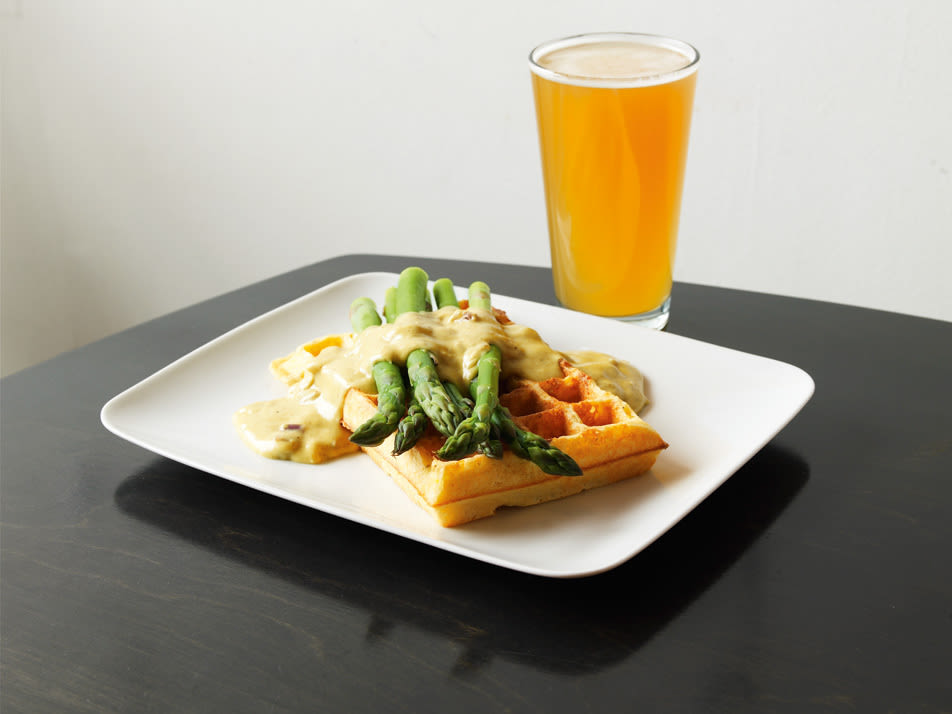
JACE GACE’s Curry Asparagus Waffle bucks the sweet trend.
Image: Stuart Mullenberg
The six or so spears of asparagus lovingly strewn atop the sumptuous cranberry-spiked curry sauce that’s drizzled over the Curry Asparagus Waffle ($8) at Jáce Gáce (pronounced “YAH-say GAH-say”) are easily the greenest ingredients in the house aside from an occasional pickle. And thank goodness: You aren’t here to eat a well-balanced meal. No, at this quaint Southeast bistro with a thoroughly modern interior, the kitchen transforms the everyday breakfast waffle into a dish worth eating any time of the day. Not only can you order, say, the Grilled Cheese Waffle ($7) just about any day of the week, you can enjoy it the grown-up way, with one of 14 bottled beers. Or, if you’re like us, you’ll skip right to the Tiramisu Waffle ($8), whose deep divots runneth over with rum, espresso, mascarpone cheese, and slivers of pear. The bad news? You’ll never be able to eat an Eggo again. The good news? Since these gourmet snacks are served in a café that moonlights as a hip art gallery, you get to feel like a savvy sophisticate while chowing down on the food of your childhood fantasies. —SW
ITALIAN
Pizza Fino
When Bella Faccia Pizzeria began serving gourmet pizzas on NE Alberta Street in 2001, the area was what you’d call “still-developing.” Now, one of the restaurant’s co-owners has opened this quaint pizzeria in Kenton—but unlike its Alberta cousin, there’s more on Pizza Fino’s menu than just pies—including at least eight hearty pastas ($7.50-11.75) and 11 sandwiches ($6.50-9). The real reason to seek out this eatery, though, is the hand-tossed pizza, like the Pocket Aces ($16 for a small), an exquisite mingling of pancetta, caramelized onions, and smoked mozzarella, served piping hot with a perfectly crunchy thin crust. For the best experience, skip the rather underwhelming dining room, which faces the parking lot, and perch yourself on one of the stools at the tiny bar. Order a slice ($2.50), and gaze through the giant picture windows at N Denver Avenue, a street that, like Alberta just a few years ago, is beginning to come into its own. —Kasey Cordell
CRÊPES
Le Happy
With cheeky offerings like Le Trash Blanc ($7.50) (a bacon-and-cheddar crêpe accompanied by a bottle of Pabst) and the sweet, not-at-all-what-Mom-used-to-make Le PNBC ($8) (a peanut butter, Nutella, chocolate, and whipped cream number), Le Happy hasn’t lost an ounce of its whimsical charm in the eight years it’s graced Portland as the city’s coolest crêperie. Spend five minutes inside its warm, red-walled environs and you’ll understand why: Even on a rainy Tuesday night at 10 o’clock, the joint is packed with boisterous locals gathered around bottles of beer and wine, all moaning over their Fromage de Chèvre et Onion crêpes ($7). But this culinary oasis isn’t merely a flophouse for fiscally challenged foodies. Between the house-made crêpe batters and the fresh-from-the-farm cheeses and veggies, Le Happy transforms this French staple into a quintessential part of Portland’s cuisine, and turns most any Portlander who wanders through its doors into a loyal Francophile. —SW
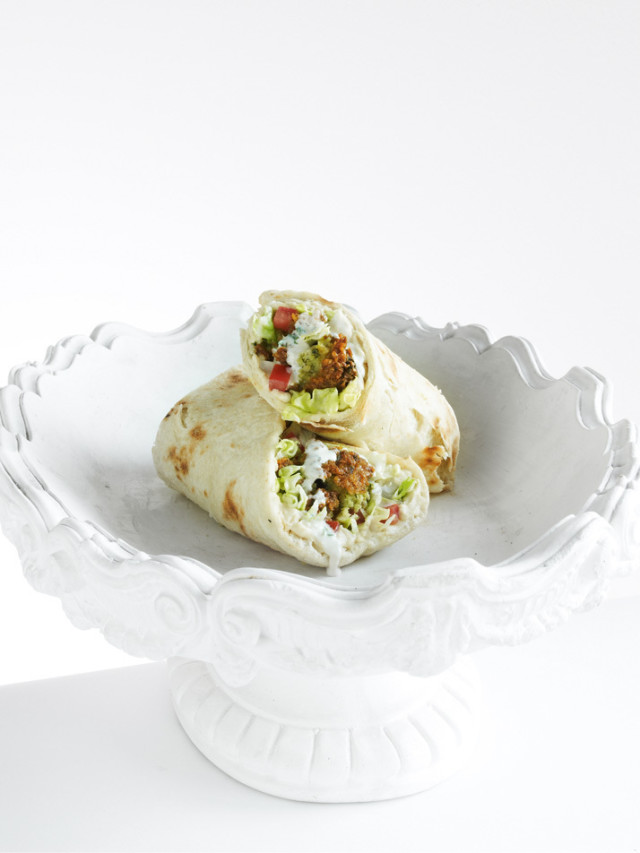
KARAM’S $6 Falafel
Image: Stuart Mullenberg
THE MASTERPIECE
Karam’s $6 Falafel
Mideast Manna
Those golden rounds of parsley-spiked chickpeas known as falafel may be one of the world’s oldest dishes—in fact, according to Middle Eastern cookbook author Claudia Roden, the Christian Copts, direct descendents of the ancient Egyptians, claim the meal as theirs. But its prevalence in Portland is relatively new. In the 1980s, Tony Karam, a native of Lebanon and current owner of the downtown Lebanese restaurant Karam (316 SW Stark St, karamrestaurant.com), used to offer free samples of his homemade falafel to Portlanders at Long Island Pizza, where he worked, but the savory morsels often went untouched. “No one wanted to try it,” he says. Today, though, thanks to Portland’s maturing culinary scene, Karam makes hundreds of falafel a day just to satisfy the demand at his restaurant. Indeed, the snack has become a staple of many Portland street carts and cafés. But not all falafel is created equal. In fact, it can go very wrong, as evidenced by the myriad dry or mealy versions being served up in—sacre coeur!—store-bought pitas. However, Karam does it right, offering up a crunchy-on-the-outside, fluffy-on-the-inside falafel snuggled into a warm pita and smothered with perfectly seasoned tahini sauce—a delicious feast with ancient roots, but one that never gets old. —KC
THE PITA:
Nothing kills a great falafel like a dry, store-bought pita, or one that was made two days ago. Karam makes his fresh every day, and ensures that they are warmed for the customer. Breaking the falafel balls inside the pita allows their flavors to mingle with the freshly cut lettuce (Karam prefers the crunch of iceberg), chopped tomato, and onion.
THE FALAFEL:
The best falafel is made from scratch, which means soaking dried chickpeas overnight in order to ensure a creamy consistency when they are puréed the next day. Egyptians originally used fava beans instead of chickpeas, and some restaurants, like Karam, mix a few in for crunchiness.
Every falafel should have a balance of freshly chopped garlic, onions, parsley, cilantro, salt, cumin, and other spices, and a bit of baking soda to make the mixture lighter. Karam prefers to dice the parsley and onions by hand instead of using a food processor, which produces liquid that can make the mixture too thin.
But the real art lies in the falafel chef’s technique: Karam wields his falafel scoop with care so as not to overwork the mixture, heaping it onto the scoop and then gently scraping off the excess instead of continually adding and compressing the mixture into a ball, which diminishes the falafel’s fluffiness.
The falafel must be fried in clean vegetable oil that’s heated to 325 degrees. Any hotter and the crust will be done before the inside has time to cook, resulting in a mushy falafel; any cooler and the falafel will likely fall to pieces in the oil.
THE SAUCE:
The element that can make or break a falafel sandwich is the tahini. Made from sesame oil, garlic, lemon juice, and salt, it’s entirely possible to turn this tasty accent into an overpowering mess by overdoing it with the garlic, salt, or lemon juice. Karam’s sauce strikes a perfect balance among each of these ingredients.
AMERICAN
Fire on the Mountain
Sure, some like it hot. But at this Portland wing joint, some also like it el jefe, bourbon chipotle, and raspberry habanero. All told, Fire on the Mountain boasts 12 distinct sauces in which to drown your poultry—which, by the way, is tender, juicy, and perfectly fried. Once you do choose a sauce, you’ll need to figure out just how many wings your party can eat: Six wings will run you $5.95; then again, 250 wings will run you $144.95, which means that if you’re feeding about 50 people, each wing lover will have to pay only around $3 for 5 wings. Either way, you’ll have enough pocket change left over for a couple of guilt-tamping house salads ($2.75) or a plate of gut-busting fries ($1.25-4.95). If the cramped N Interstate Avenue location leaves you claustrophobic, head to the larger location on E Burnside Street. Wherever you end up, don’t forget to sign up for their monthly e-mail alert that announces 25-cent wing days (yes, really). Now that’s hot. —KC
THAI
Pok Pok & Whiskey Soda Lounge
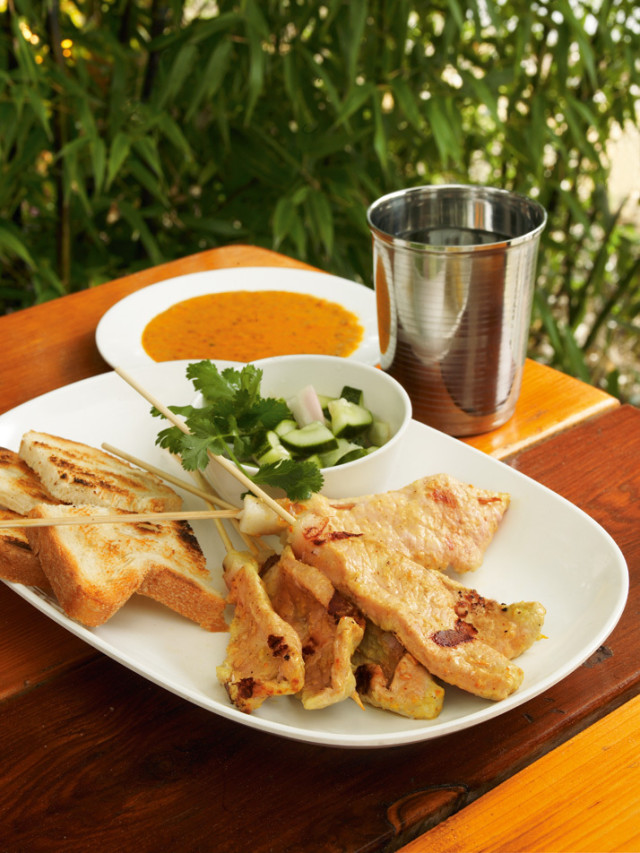
Muu Sateh and all its accompaniments at POK POK & WHISKEY SODA LOUNGE
Image: Stuart Mullenberg
Not everything on the menu at this Southeast Asian hot spot qualifies as cheap, especially considering the small size of some of the dishes. But since most are meant to be shared, and at least a few are generous enough to fill one person’s belly and then some, you can certainly enjoy a rich man’s feast at poor man’s prices if you know what to order. For two people, a whole order of the kai yaang ($11), an addictive charcoal-roasted game hen stuffed with lemongrass, garlic, pepper, and cilantro; and a big bowl of khao soi kai ($11.50), a mild but flavorful Thai curry noodle soup, are more than enough to satisfy. You’ll even have a few bucks left over for a light snack of shrimp chips or house-roasted peanuts before the entrées arrive. But, while we’re all for intimate tables for two, it may be worthwhile to bring a number of dining companions along. A group of four could order six dishes—from caramelized Vietnamese chicken wings to a mint-and-lamb curry soup—ranging in price from $8 to $11, and each diner would end up paying no more than around $15 before tip, if that. We promise no one will go home hungry or disappointed. —CD
CUBAN
Pambiche
There’s a lot of inexpensive food out there that’s served in less-than-swanky digs. But at this Cuban hangout, touches like the conga-worthy music pouring from the speakers and the red and orange walls bedecked with handicrafts feed the soul while you feed your stomach. Chow down on a simple Plato Comunista ($8.00 for lunch; $11 for dinner), a plate of rice and beans with fried yucca and a beet or cabbage salad, or a couple of empanadas filled with spiced meat or potatoes ($4 each) plus a salad of fresh avocado, sliced red onion, and a sour-orange vinaigrette ($6.75). A classic Sanwich Cubano of roasted pork, smoked ham, Swiss cheese, and dill pickles may run you $9.75 for dinner, but it’s a filling indulgence nonetheless. In fact, just about everything is—including all those tropical-inspired cakes by the register, which go perfectly with a cup of café cubano. —CD
MIDDLE EASTERN
Hush Hush
We’ve already sung the praises of Karam’s ethereal falafel. But there’s room for more than just one Middle Eastern hot spot in this town. (In fact, Karam and Hush Hush are mere blocks from each other.) And while the quiet name of this hidden downtown gem may suggest otherwise, the flavors and aromas that permeate Hush Hush announce themselves with an undeniable, audible confidence. Behind the counter, two spits sporting hunks of seasoned lamb and chicken shawarma turn round and round daily, the smell of succulent, roasted meat emanating into the dining room. In the back kitchen, someone’s forming circles of pita by hand, the comforting smell of warm dough wafting through the air. At the tables, diners feast on stuffed grape leaves ($5), tender lamb sandwiches ($6.50), airy spinach pies ($5.50), and honeyed baklava ($2). They are sated and happy, these loyal diners on their lunch breaks or just in for a quick dinner before driving home from work. And so is owner Nezam Hammad. How can we tell? By the perpetual grin on his face every time he briefly looks up from all those kabobs he’s carefully attending to on the grill. —CD
CHINESE
Hot Pot City
All-you-can-eat buffets may allow you to pile up your plate with all the food your stomach desires, but the food usually just plain stinks. Luckily this clean and airy Chinese hot-pot spot finally gets the formula right by letting customers do all the cooking themselves.
Here’s how it works: Find a seat at the wooden bar (or at a table if you’re a large group), where an attentive server will ask which broth you want—there are seven kinds, ranging from mild vegetarian to spicy hot-and-sour. Then head to the buffet line and load a plate up with raw ingredients—thin slices of beef and pork, bite-sized pieces of chicken, chunks of tofu, slices of bok choy, and more. Finally, mix up your own sauce, maybe augmenting a base of premixed soy sauce, chile, and lime juice with “Taiwanese barbecue sauce.”
Once the server has placed the pot of broth over your individual burner and it’s begun to boil, you’re ready. Plunge a few morsels in, and as each bite cooks to your satisfaction, ladle it into your serving bowl with a bit of broth. Add some sauce, and then eat. Repeat. It’s a fantastic all-you-can-slurp deal at just $7.95 for lunch or $13.95 for dinner. And since you’re the official mix-master of the dish’s flavor, you’ve nobody to blame but yourself if it isn’t to your liking. —CR
Ethiopian
Queen of Sheba
Despite the name, this is not necessarily a regal establishment: Primitively embroidered tablecloths sheathed in plastic is about as fancy as it gets. But the flavorful food—while consisting mostly of humble ingredients such as split peas, mustard greens, chicken, beef, and lamb—always rises to the occasion. A typical meal here features a medley of headily spiced meats, vegetable stews, and sautés, all served family-style atop a gargantuan, 16-inch-wide sourdough crêpe made from teff flour. Tear off a piece of that spongy bread—called injera—and use it to scoop up mouthfuls of mushroom, okra, and beef sautéed in a deep red, spicy-hot berbere sauce. A couple of omnivores can eat heartily by ordering two meat dishes ($12-15) and adding a few vegetable sides ($3 each), while vegans will delight in the house vegan sampler ($23). What with all the communal eating, both types of eaters can be found side by side, chewing in peace for a fair price. —CR
AMERICAN
Michael’s Italian Beef & Sausage Co
It should be noted that this is not the ideal place to go on a first date—and for that, we blame the roast beef sandwich. Stuffed into fresh Italian bread from Portland French Bakery, the thin, succulent, juicy slices of meat drip constantly. All over your fingers. Onto your face. And onto your new white shirt—which can be a beautiful sight, actually, so long as you’re not worrying whether your date thinks you’re a slob. Deciding between the roast beef sandwich ($7.45) and the superb sausage sandwich ($7.10) can be vexing, but solutions abound. Order one of each and split them, or pounce on a Chicago-Style Combo ($8.70), which offers mounds of sopping-wet beef and hearty chunks of fennel-spiked house-made sausage. Be sure to opt for the topping of marinated hot peppers: The jovial kitchen crew will laugh at you if you don’t. —JC
GERMAN
Otto’s Sausage Kitchen
With 24 varieties of handmade sausages filling its refrigerated shelves, this 80-year-old, family-run Woodstock institution is a candy store for carnivores—not that meat lovers need to actually set foot inside to enjoy the bounty. Every day at 11 a.m., the Otto’s crew fires up their outdoor smoker and piles on goodies like chicken sausages ($2.75), smoked pork links ($2.75), and old-fashioned wieners ($1.75). You can, of course, just as easily satisfy a hearty appetite inside, with hot sandwiches like the Kitchen Sink ($5.75). Chock-full of pastrami, salami, summer sausage, Swiss cheese, and smoked Munster, it’s a true belt-buster. For tossing into a picnic basket, consider the Orchard Sandwich ($4.95), stuffed with layers of cold-cut hunter sausage, havarti cheese, and sliced green apples. Don’t want to walk all the way to the Reed campus and set up your spread on the lawn? Simply claim one of the wooden tables lining the sidewalk, among the best picnic spots in town. —B. Barker
MEXICAN
¿Por Qué No?
“Why not?” poses this tiny North Portland taqueria’s name. Why not put boutique browsing on pause and weave your way through the cluster of outdoor tables to the inevitable line at the counter? Why not bite into a warm, thin homemade corn tortilla that envelops succulent braised local meats and roasted seasonal vegetables? Because you can’t go wrong with any of the nine tacos on the menu at this cheery and bright taqueria. That said, you should never forgo the carnitas taco, made with tender Carlton Farms pork, drizzled with tomatillo sauce, and topped with Willamette Valley queso fresco, chopped onions, and cilantro. Nor the smoky Porque Tinga, a perfect combination of shredded Cascade Valley beef smothered in smoky pasilla chile sauce, salsa roja, and cilantro. Sure, you might find yourself sipping that margarita standing up as you wait for one of the seven indoor tables to clear, but at only $2.50 to $4 per delicious taco, who cares about a little inconvenience? —KC
EUROPEAN
Foster & Dobbs
Nestled in the lush environs of the Irvington neighborhood, it’s easy to imagine Foster & Dobbs as an old European country store, a relic of the past when “artisanal” was not a buzzword, but a way of life. Exceptional olive oils, chocolates, wines, and dried pastas line the store’s shelves, but it’s what’s inside the meat and cheese case that customers pay most attention to. You can get hunks of aged gouda and salami to go, but the four tables inside and four outside may entice you to sit and savor meals like the Ploughman’s Lunch ($5 plus the cost of the cheese), which lets you combine salad greens, a pickle, and bread with any cheese from the vast glass case. The sandwiches are similarly inventive. Our favorite? The Mole Salami ($7.50), with sharp cheddar, tomato-chile jam, and greens (though we’re also partial to the outstanding creation in which Beecher’s Flagship cheddar is melted on a baguette and smothered with piquant mango chutney and sweet hot mustard). Pair your lunch or early supper with a Belgian beer, and you may never return to the city again. —MC
Food Styling by Carolyn Schirmacher

